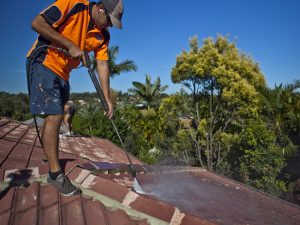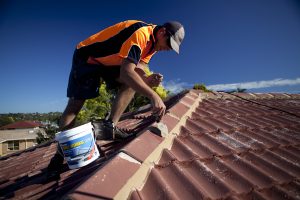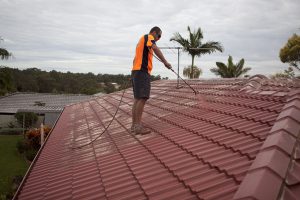How do you restore our roof?
The process for roof restoration varies slightly depending on the roof type. The example below is typical for a concrete tile roof or metal roof, for more information visit the roof restoration page:
Step 1 – Repairs
On a tiled roof, any broken or cracked tiles must be replaced. On a metal roof, any re-screwing or sheet replacement should be done first. Any other repairs such as replacement or repairs to flashings (this applies to both tiled and metal roofs) should be done before moving to the next step.
Step 2 – Pressure Clean
 The roof must be pressure cleaned thoroughly with a minimum of 3000 p.s.i (pound per square inch) pressure. An average household Gurni will typically put out less than a third of this so an industrial strength water blaster is required.
The roof must be pressure cleaned thoroughly with a minimum of 3000 p.s.i (pound per square inch) pressure. An average household Gurni will typically put out less than a third of this so an industrial strength water blaster is required.
The power of the water blaster is paramount on all types of roofs but especially tiled roofs because roof tiles, by the time they are 10 years old, have lost their glaze. Once the glaze has eroded, the coating underneath oxidises and becomes very chalky. This chalkiness must be removed, along with the dirt and grit that’s on the surface and in the craters and pores of the tiles.
Special attention must be given to cleaning the tile noses (the ends of the tiles). Where most people come unstuck in cleaning a tiled roof is in cleaning the tile noses. If you ever see a bad roof restoration job, the first thing that stands out is how the ends of the tiles are black. This is simply because they weren’t sufficiently cleaned.
An inexperienced cleaner will avoid cleaning the noses, though, through fear of flooding the ceiling cavity. You see, done the wrong way, cleaning the tile noses will push water up under the tiles and into the roof. It’s catch 22. You have to get them spotless, but you don’t want to flood the ceiling!
To avoid flooding the ceiling, you need to hold your lance at around 60 degrees and you must move fast to avoid putting too much water in one place.
WARNING: If you are restoring a pre-painted roof, refer to our article titled “Why Roof Restorations Fail” in the “How Long Do Roof Restorations Really Last” section of the FAQs for recommendations on how a roof that’s been painted before should be prepared.
Step 3 – Re-bedding and pointing
 If yours is a tiled roof, it will more than likely need re-pointing and perhaps even re-bedding. If it needs re-bedding (it will need re-bedding if the ridge caps are loose), this involves removing the ridge caps and laying a new concrete bed. You should hire bedding rails (these can be hired or bought from some roof tiling supplies yards) to get a neat and straight bed. Mix sand and cement with a 4 : 1 mix, and add a plasticiser to the mix to help it stand up. The ridge caps are then laid on your new cement bed.
If yours is a tiled roof, it will more than likely need re-pointing and perhaps even re-bedding. If it needs re-bedding (it will need re-bedding if the ridge caps are loose), this involves removing the ridge caps and laying a new concrete bed. You should hire bedding rails (these can be hired or bought from some roof tiling supplies yards) to get a neat and straight bed. Mix sand and cement with a 4 : 1 mix, and add a plasticiser to the mix to help it stand up. The ridge caps are then laid on your new cement bed.
Once the bedding is dry (next day is best but you can point over a new bed same day on warmer days) you can apply the pointing. A polymer-based flexible pointing mortar should be used. The flexibility is vital as roofs are subject to a lot of movement and you need a mortar than can cope with this movement. The pointing should be applied with a pointing trowel at between 3mm and 5mm thickness. Any thicker will make the mortar skin over but not dry properly underneath the skin and the pointing will sag.
In most cases, if the ridge caps were not loose, re-bedding is not required, in which case you would miss this stage and just apply the pointing over the top of the existing pointing.
Step 4 – Primer
The next stage is to apply the primer or sealer. You should leave the pointing to dry over night and apply the primer/sealer the next day.
For a tiled roof you should use a concrete tile primer or sealer. For a metal roof, you need a “Gal” primer.
Using an airless paint machine with a 5/19 tip, you should apply the primer using the recommended coverage rates. The coverage rates depend on whether or not the roof is pre-painted. For a non pre-painted roof, you’ll need approximately 15 litres per 100m2 for a tiled roof, and approximately 10 litres per 100m2 for a metal roof. With a pre-painted roof you’ll use more. How much more will depend on the thickness of the previous coating (if you couldn’t get it all off). The thicker the previous coating and therefore the more pronounced the edges are, the more primer you’ll need. It’s difficult to give exact coverage rates in these situations but it can be up to 50% more than is required on a non pre-painted roof.
Step 5 – Filler Coat if required
With a tiled roof, if the roof is quite bare and/or rough, then you should use a filler coat to “build” the surface and smooth it out. This will give you a much nicer finish with the top coats and avoid the patchy look you often get when re-coating old bare roof tiles. As with the primer, you should use an airless paint machine, however, a larger tip is required for applying filler coat (a 5/21 is usually sufficient).
Step 6 – Two Top Coats
 Using an airless paint machine with a 5/19 tip, you should apply the top coats using an up and down (from gutter to ridge) pattern, getting a full stroke from the gutter to the ridge and full stroke back down again wherever possible. This avoids join marks in the coating and is especially important on a metal roof where join marks show up significantly.
Using an airless paint machine with a 5/19 tip, you should apply the top coats using an up and down (from gutter to ridge) pattern, getting a full stroke from the gutter to the ridge and full stroke back down again wherever possible. This avoids join marks in the coating and is especially important on a metal roof where join marks show up significantly.
Make sure you angle the gun upwards towards the tile noses (ends) as they need very thick coverage due to their roughness and craters. Some applicators will actually spray the bottom 3 rows of noses first (going around the roof instead of up and down) as they are the hardest to get good coverage on due to the angle you need to hold your gun at being difficult to achieve as you get close to the edge of the roof.
Whichever way you do it, on a tiled roof, make sure that you get super thick coverage on the tile noses. This is one major difference between a good job and a bad job. On the amateurish jobs, the noses will be too thin and will go black within a couple of years.
The coverage rate you need to aim for depends on the roughness and porosity of the tiles. As an average, most roof coatings will cover well at 1 litre per 5 metres per coat (1 : 2.5 including both coats). If you cover at these rates and the roof still looks like it needs more coating, you will need to apply another coat. If you do a very rough or bare roof, allow for 3 top coats (or use a filler coat as your first top coat – the coverage rate for filler coats is approximately the same as for the standard top coats, although you might want to apply it slightly thicker to give you an even better finish).
Step 7 – Hand Painting and Cutting In
Most roofs will have some parts that can’t be sprayed. For example, barge capping, dutch gabes, lead flashings where they go into a wall, etc. These parts will need to be hand painted.
Drying Times
Check your paint manufacturers recommended dry times and stick with these because it will affect your warranty.
As a guide, though, at 20 degrees C plus, most water based roof coatings can be over-coated within an hour. At 15 – 20 degrees, it can be 2 – 3 hours. 10 – 15 degrees will need 3 – 4 hours, on average. Under 10 degrees may need to be left until the following day before you over-coat.
Avoiding Over-spray
Any nearby walls, dutch gables, finials, sky lights, or other items on the roof should be masked up or covered with tarps or plastic. You can purchase masking tape and plastic from most hardware stores or paint shops.
Never spray on gusty days. Slight breezes are usually okay but never spray in high winds.

